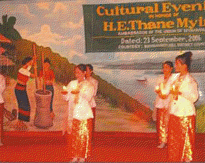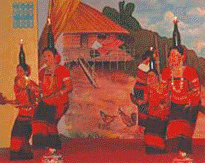|
News/Feature/Article:
Indigenous
cultural programme in Rangamati
Shantimoy
Chakma, Rangamati: Rangamati Hill
District Council (RHDC) recently organised a cultural evening to honour the
visiting ambassador of the Union of Myanmar, Thane Myint at the local Tribal
Culture Institute (TCI) auditorium.
Indigenous
artistes of the Chakma, Marma, Tangchangya, Tripura and Lusai communities
performed songs and traditional dances at the event.
 Dancers
of the Marma community performed a "Candle dance", balancing lit
candles set on small plates on their palm. This was followed by a
"Bamboo dance" performed by artistes of the Lusai community. Dancers
of the Marma community performed a "Candle dance", balancing lit
candles set on small plates on their palm. This was followed by a
"Bamboo dance" performed by artistes of the Lusai community.
Suchanda
Tangchangya performed a love song titled O-re-o-baier-an,
jare-tuiparandare-koidegoina. Aungthoai Marma and Subhadra Tripura performed
tradition songs while Kalayan Chakma and Shila Chakmsa performed a duet
song.
Chakma
artistes also performed a traditional "Bizu dance." The Chakma
community celebrates "Bizu Utsab," ushering in the New Year at the
end of Bangla month of Choitra. Tripura artistes wrapped up the programme
with a "Bottle dance".
Earlier,
ambassador Thane Myint visited the museum of TCI and admired the collection
of different traditional items.
Source:
http://www.thedailystar.net/2006/09/26/d609261402122.htm
From
the land of the sunrise
Sanam
Amin talks to photographer Mahmud whose exhibition of photos on the life
and struggles of the Mro peoples opened in Dhaka this week.
The
Mro people, also known as the Murong, are believed to have come to the
Chittagong Hills sometime in the late 1500s, after their defeat in a clan
war in the Arakan hills. When they first met the Bangalees in Busidong,
Bandarban, there was a language barrier between the two peoples, and the
Mros were not understood when they introduced themselves saying ‘Ang ing
shut lot honka wangrungme mru’ which means ‘We are the people coming
from the land of the sunrise’. They then shortened this to ‘Ang ing mru
rung’ which means ‘We are the new people’. The Bangalees picked up on
‘mru rung’ and pronounced it as ‘Murong’ and so to this day, if they
are known at all, they are known as the Murong. This week, an exhibition of
photographs by Mahmud opened at Dhaka’s Drik Gallery, focusing on the Mro
people of the Chittagong
Hill Tracts, and bringing to light their rich traditions, history and
culture.
Ten
years ago, photographer Mahmud, who heads the Map Photo Agency, wanted to go
to Bandarban and live amongst the Mros, learn about their culture, and of
course, take pictures to show the rest of the world. The government of the
day, refused him access, deeming his project ‘politically incorrect,’ as
he puts it. He had to wait until 2002 before it was not so incorrect.
Between then and 2005 he spent nearly a hundred days in Mro villages,
listening to folk tales and photographing as much as possible. The result is
this travelling exhibition, titled ‘Life & Struggles of the Mro People
in Bangladesh’ which began in July in Bandarban, and is making a total of
thirty stops around the country, from Dhaka to Jessore to Sylhet and many
other regions. It is all part of Mahmud’s effort to make the Mros better
known. ‘It’s our responsibility to tell people—we should not be unjust
to others. They should have comfort and an opportunity to flourish just the
same as we do,’ he says. ‘They are neglected and exploited by us, the
majority, whatever form you talk about—the army, civil servants, the
government.’
 These
people, like the rest of the hill peoples, never thought that they would
need government authorisation and documents to continue living on their
ancestral land. Until all land transactions in the Chittagong Hill Tracts
were stopped in 1998, thousands of acres went to people intent on making
fruit and rubber plantations. The Mros were driven further into the hills to
survive. ‘They didn’t have papers, and so all this land went into the
hands of government officials, businessmen, politicians, army and civil
servants. They made themselves some nice orchards; and then the government
gave out permanent leases for five acres to some people. So one day you find
your neighbour digging up what was your space, and he shows you some
official documents that allows him to do what he wants.’ As of right now,
about 18,000 applications for permanent leases are waiting to be processed
in the Bandarban Deputy Commissioner’s office. The Bangalee population has
grown to such an extent in Bandarban in the last twenty-five years that the
hill peoples have become a minority in their own land, Mahmud explains. These
people, like the rest of the hill peoples, never thought that they would
need government authorisation and documents to continue living on their
ancestral land. Until all land transactions in the Chittagong Hill Tracts
were stopped in 1998, thousands of acres went to people intent on making
fruit and rubber plantations. The Mros were driven further into the hills to
survive. ‘They didn’t have papers, and so all this land went into the
hands of government officials, businessmen, politicians, army and civil
servants. They made themselves some nice orchards; and then the government
gave out permanent leases for five acres to some people. So one day you find
your neighbour digging up what was your space, and he shows you some
official documents that allows him to do what he wants.’ As of right now,
about 18,000 applications for permanent leases are waiting to be processed
in the Bandarban Deputy Commissioner’s office. The Bangalee population has
grown to such an extent in Bandarban in the last twenty-five years that the
hill peoples have become a minority in their own land, Mahmud explains.
A
census conducted by Mro Social Culture in 1995 says that the Mro population
then was 59,748. Since then, Mahmud estimates that they now number about
49,000. ‘The death rate is rising,’ he says. ‘I’ve interviewed
mothers who at age forty have lost all their children from diarrhoea or
cholera. I myself suffered nine attacks while I was there, so I can imagine
how much harder it must be when someone is under five years old and
suffering…’
The photos displayed are a handful chosen from ‘six or seven thousand’.
They are all very candid and vibrant, and the subjects seem hardly
self-conscious at all. ‘That is because they accepted me as their own,’
explains Mahmud. There are several paragraphs of explanation and folktales
accompanying the photos, because, he says, ‘I cannot be judgmental—I’m
not the person to say what is right or wrong.’ He objects to making
blatant statements such as ‘Mros eat dogs.’ True, they do eat dogs, but
one must also remember that ‘in the hills, everything is precious,
everything is food. Everything takes a lot of effort—you need half an hour
just to get a bucket of water. You can’t afford to throw anything away.’
He has included an elaborate description of the death rituals to explain as
well—when a person dies, a dog and a cockerel are killed as well, because
the dog’s soul is needed to guide the person on the journey to heaven, and
the cockerel is to eat the maggots that are actually disguised evil spirits
that will obstruct the soul’s path. Mahmud says he has tried his best to
be objective in representing the Mro people and culture—‘I do the
research, I do the writing. I try to keep as close as possible to their
words, and I write in Bangla first and then translate to English.’ His
main task is to make them better known to the rest of the country at least;
as he puts it, ‘it’s so close and so far…It’s my job to make these
people known. And it is a big privilege, I am very lucky to have been
accepted into their lives.’
Ten
percent of the proceeds from the book Mahmud has put together as a
culmination of this project will go to maintaining a private school in
Bandarban—‘I wanted to thank the community in some way.’ The school
has about 35 students and was running short of money before Mahmud contacted
the local NGO that funds it and offered to help keep the school going.
The
Mro community, he says, were very happy and proud to see the exhibition, the
result of all his work. Mahmud says there is much to learn from them—for
instance, the respect they have for women and mothers. ‘The bride price
includes ten silver coins for the bride’s mother, as payment for her milk
and for bearing her daughter in her womb.’ Mro girls do not get married
until at least eighteen, because they understand that Mro women have to be
mature enough to bear children, to run a household. Many men prefer having
older wives who are capable of these things, and many in fact do marry older
girls at the age of sixteen.
Mahmud
recounts that when he asked about the crime rate, he was told hear that
there were no cases of rape or murder. ‘There is respect amongst them,’
he says, not just for human beings. He says that once, noticing that they
had many cows, he made the mistake of asking for some milk. ‘They replied,
“But the cow’s milk is for her calf, not for you!” And they couldn’t
understand how I could have thought of taking the cow’s milk for
myself.’
Source:
http://www.newagebd.com/2006/aug/18/aug18/xtra_inner3.html
|